市场资讯及洞察
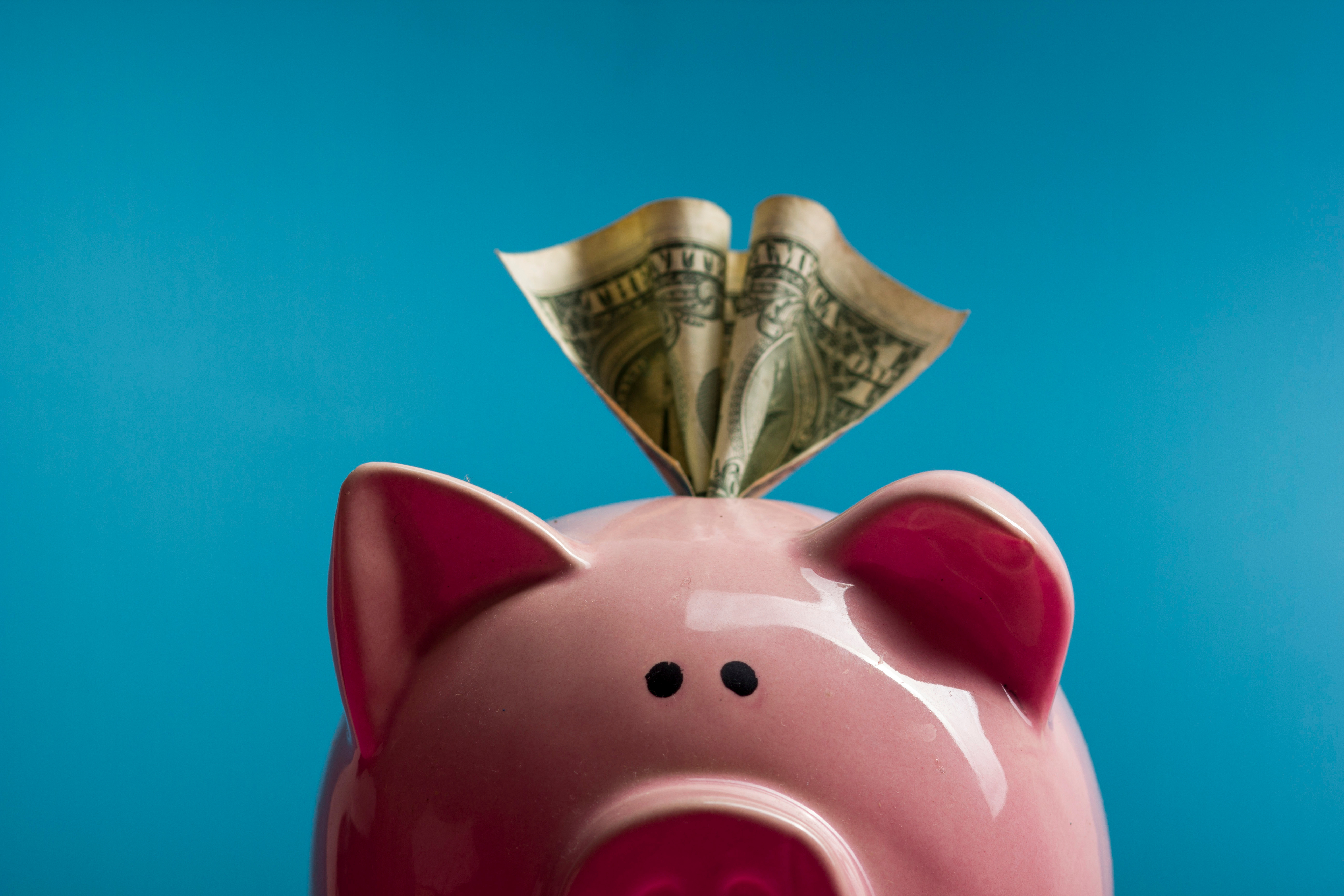
S&P 500 and ASX Rally as Big Banks Drive Markets
Both the S&P 500 and ASX have rallied on the back of stronger-than-expected major bank earnings reports on both sides of the Pacific.
In the US, Bank of America reported a 31% year-over-year increase in earnings per share at $1.06, exceeding Wall Street's estimate of $0.95. Meanwhile, Morgan Stanley delivered a record-breaking quarter with EPS of $2.80, a nearly 49% increase from the same period last year.
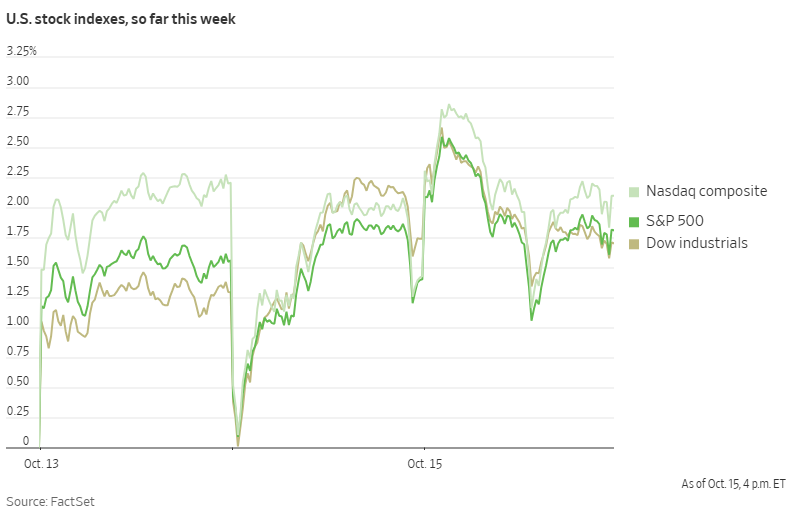
On the Australian front, the benchmark ASX 200 leapt 1.03% to 8990.99, with all four major Australian banks playing a major role. CBA closed 1.45% higher, Westpac 1.98%, NAB 1.87%, and ANZ 0.53%.
These strong bank results indicate broader economic strength, despite recent concerns about US-China trade tensions. US Treasury Secretary Scott Bessent emphasised that Washington did not want to escalate trade conflict with China and noted that President Trump is ready to meet Chinese President Xi Jinping in South Korea later this month.
With the third-quarter earnings season just getting underway, these early positive results from financial institutions could prove as the start of continued market strength through to the end of the year.
U.S. Government Shutdown Likely to Last Into November
Washington remains gridlocked as the U.S. enters its 16th day of shutdown. With no signs of compromise on the horizon, it appears increasingly likely the shutdown will extend into November and could even compromise the Thanksgiving holiday season.
Treasury Secretary Scott Bessent has warned "we are starting to cut into muscle here" and estimated "the shutdown may start costing the US economy up to $15 billion a day."
The core issue driving the shutdown is healthcare policy, specifically the expiring Affordable Care Act subsidies. Democrats are demanding these subsidies be extended, while Republicans argue this issue can be addressed separately from government funding.
The Trump administration has taken steps to blunt some of the shutdown's immediate impact, including reallocating funds to pay active-duty soldiers this week and infusing $300 million into food aid programs.
However, House Speaker Mike Johnson has emphasised these are merely "temporary fixes" that likely cannot be repeated at the end of October when the next round of military paychecks is scheduled.
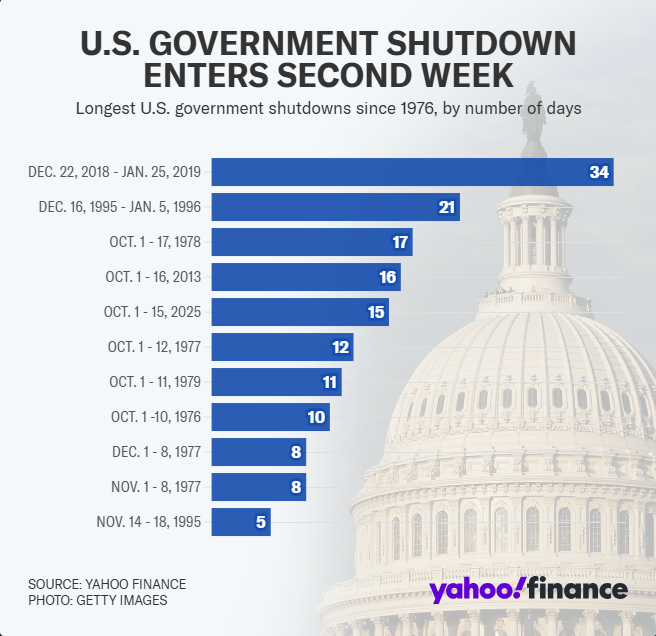
By the end of this week, this shutdown will become the third-longest in U.S. history. If it continues into November 4th, it will surpass the 34-day shutdown of 2018-2019 to become the longest government shutdown ever recorded.
This prolonged shutdown adds another layer of volatility to markets. While previous shutdowns have typically had limited long-term market impacts, the unprecedented length and timing of this closure, combined with its expanding economic toll, warrant closer attention as we move toward November.
Trump Announces Modi Has Agreed to Stop Buying Russian Oil
Yesterday, Trump announced that Indian Prime Minister Narendra Modi has agreed to stop purchasing Russian oil. He stated that Modi assured him India would halt Russian oil imports "within a short period of time," describing it as "a big step" in efforts to isolate Moscow economically.
The announcement comes after months of trade tensions between the US and India. In August, Trump imposed 50% tariffs on Indian exports to the US, doubling previous rates and specifically citing India's Russian oil purchases as a driving factor.

India has been one of Russia's top oil customers alongside China in recent years. Both countries have taken advantage of discounted Russian oil prices since the start of the Ukraine invasion.
Analysis suggests India saved between $2.5 billion to $12.6 billion since 2022 by purchasing discounted Russian crude compared to other sources, helping support its growing economy of 1.4 billion people.
Trump suggested that India's move would help accelerate the end of the Ukraine war, stating: "If India doesn't buy oil, it makes it much easier." He also mentioned his intention to convince China to follow suit: "Now I've got to get China to do the same thing."
The Indian embassy in Washington has not yet confirmed Modi's commitment. Markets will be closely watching for official statements from India and monitoring oil trading patterns in the coming weeks to assess the potential impact on global energy flows and prices.
Chart of the Day - Gold futures CFD (XAUUSD)


In the world of trading, irrespective of what instrument or timeframes you are choosing to trade, losses aren't just inevitable—if you choose to embrace the opportunity they present, they also have the potential to be massively educational.According to studies from the Financial Industry Regulatory Authority, nearly 70% of retail traders experience significant losses within their first year of trading across all asset classes. Yet behind almost every successful trader's story, regardless of their market specialty, lies a narrative of devastating setbacks followed by remarkable recoveries.As Warren Buffett famously stated, "The most important quality for an investor is temperament, not intellect."In this article, where the current tariff-induced market shock is still very much on trader minds, we will look at how successful traders transform their losses—both in the contexts of everyday trading setbacks and catastrophic market shocks—into the foundation for their greatest comebacks.Clearly, although I am making some broad generalisations, the causative factors and response to loss will be unique to the individual trader. Your job when reading this is to “look in the mirror” and honestly appraise your losses and grab the elements of loss recovery that are a fit for you as a trader in whatever markets you choose to trade.The Psychology of Loss: Understanding Your Brain on Red NumbersWhen your portfolio turns red, your brain experiences a similar neurological response to physical pain. Neuroscience research has revealed that financial losses activate the same brain regions as physical threats, triggering fight-or-flight responses that can derail rational decision-making.The typical emotional cycle following a significant loss includes:
- Denial – "This is just a temporary pullback"
- Anger – "The market is rigged against retail traders"
- Bargaining – "If I can just get back to breakeven, I'll never make that mistake again"
- Depression – "Maybe I'm not cut out for trading"
- Acceptance – "This loss is now data I can use to improve"
While this cycle is natural, successful traders accelerate their journey to acceptance. As trader and author Mark Douglas writes, "The faster you can accept a loss, the quicker you can learn from it."Clearly the basis of this, and much of what is at the foundation of trading recovery, is “owning” your situation, taking responsibility for what has happened but also the chance to use this to create your trading future.The Post-Loss Analysis Framework: Turning Pain into DataRather than rushing to recover losses, elite traders first engage in systematic analysis. Here's a framework for transforming losses into actionable intelligence:
- Separate Market Factors from Execution Errors
Ask yourself: Was this loss due to unforeseeable market events or flaws in your execution? Categorising losses helps identify which elements were within your control. Of course, these are the things you can positively influence in future planning.For market factors: Document the specific conditions that led to the loss to recognise similar setups in the future.For execution errors: Break down each decision point where different choices could have mitigated the loss.
- Identify Emotional Triggers
Review your trading journal (if you don't keep one, start today, as anyone who has heard me teach will have heard before) to pinpoint emotional states that preceded poor decisions. Where any of these the case for you.
- Were you trading larger sizes after a series of wins?
- Did outside life stressors affect your focus?
- Were you trading out of boredom or FOMO?
- Were you unwell or have significant events outside of your trading?
I have spoken many times on the need to monitor your “trading state” with the ultimate sanction of course of temporarily removing yourself from trading or at least adapting your trading to account for any increased risk to optimum decision making in the heat of the market action.As Peter Lynch noted, "Know what you own, and know why you own it." This applies equally to understanding why you make certain trading decisions.
- Quantify Position Sizing Impact
Many devastating losses stem not from incorrect market analysis but inappropriate position sizing. Calculate how different position sizes would have affected the outcome:
- What would the loss have been at 25% of your actual position size?
- How would scaling in rather than entering all at once have changed the outcome?
- Did you violate your own risk management rules?
- Evaluate Your Original Trading Ideas
Revisit your original trading ideas and strategies with brutal honesty:
- What evidence supported your idea?
- What contradictory signals did you ignore?
- Was your time frame appropriate for the setup?
Remember Buffett's wisdom: "When you find yourself in a hole, stop digging." Recognising when a (trading) thesis is invalidated is as important as forming one.Having said this, this does play into the narrative that the major influence is all about entry. Invariably, and as many experienced traders will recognise, it is as much about exits. Ask yourself similar questions about YOUR exits such as:
- What evidence supported your decision to stay?
- What contradictory signals did you ignore that were suggestive it may have been technically or fundamentally prudent to get out?
- Did I get greedy and see a win disappear and turn into a loss because my exits didn’t account for changing market conditions.
Navigating Market Shocks: When Everyone PanicsWhile individual trading losses are challenging, market-wide shocks present unique recovery challenges across all trading vehicles. Events like the 2008 financial crisis, the March 2020 COVID crash, or the 2022 tech sector collapse create systemic disruptions in stocks, forex, commodities, cryptocurrency, and futures markets alike. These cross-asset dislocations require specific recovery strategies that work regardless of what you trade.Phase 1: Survival ModeWhen markets experience shock events, liquidity often disappears precisely when you need it most. During these periods:
- Reduce position sizes by 50-75% until volatility normalizes
- Increase cash reserves to capitalize on opportunities when stability returns
- Identify which assets are experiencing liquidity crises versus fundamental revaluations
As Ray Dalio explains, "The biggest mistake investors make is to believe that what happened in the recent past is likely to persist."Phase 2: Opportunity AssessmentMarket shocks create dislocations between price and value across all asset classes. Once the initial panic subsides:
- Look for quality assets trading at distressed prices, whether they're currencies, commodities, cryptocurrencies, or traditional securities
- Identify market segments experiencing forced selling rather than fundamental deterioration
- Analyse historical recovery patterns from similar market events across your specific trading vehicles
Although these principles are often applied to stocks, this same may be equally relevant to selecting specific currencies, commodities, or cryptos that show strength during recovery phases.Signs a Market Shock Is SubsidingRecognising when a market shock is ending is crucial for timing your re-entry. Look for these cross-asset indicators:
- Volatility Normalization: When instruments like the VIX for stocks, MOVE index for bonds, or historical volatility metrics for forex and crypto begin trending downward consistently over multiple sessions.
- Volume Patterns: Panic selling typically peaks with extraordinary volume. When volume returns to more normal levels while prices stabilize, the acute phase of the shock may be ending.
- Correlation Breakdown: During shocks, correlations across assets approach 1.0 as "everything moves together." When correlations begin normalizing and assets resume individual price paths, recovery may be underway.
- Institutional Positioning: When the commitment of traders (COT) reports, fund flow data, or whale wallet movements (in crypto) show smart money beginning to accumulate, the worst may be over.
- Media Sentiment Shift: When mainstream financial headlines shift from panic to "bargain hunting" or "value spotting," sentiment may be improving.
Phase 3: Strategic Re-entryRe-entering the market after a shock requires methodical execution, regardless of what you trade:
- Start with small positions (25% of your normal size) whether you're trading equity indices, currency pairs, commodity futures, or cryptocurrencies
- Scale in gradually over weeks or months rather than days, adapting the timeframe to the typical volatility cycle of your specific market
- Prioritize liquid instruments with tight spreads—major forex pairs over exotics, large-cap stocks over small caps, bitcoin over microcaps, front-month futures over back months
- Set defined markers for increasing exposure that make sense for your trading vehicle (e.g., "When VIX drops below 25, I'll increase stock position sizes by 15%" or "When 30-day realized volatility in EUR/USD returns to pre-crisis averages, I'll increase forex exposure by 20%")
- And of course, begin to put in place some of the lessons you have learned from your evaluation as to what you could have done differently. To go back to the same again is unlikely to serve you well.
Risk Management 2.0: The Post-Loss EditionRecovering from significant losses demands refined risk management, regardless of which markets you trade. Consider implementing these cross-asset approaches:The 2% Recovery RuleUntil you've recovered psychologically and financially from major losses, limit each trade's risk to 1% of your current account size—not your pre-loss portfolio.This prevents the common mistake of trying to "get it all back at once." This principle works whether you're trading corn futures, Japanese yen, technology stocks, or Bitcoin. Traders often make the mistake of using different risk parameters across different markets, but during recovery, consistency in risk approach is crucial.For leveraged instruments like futures and forex, this means being especially vigilant about effective position sizing. A 2% account risk in a 50:1 leveraged forex position requires much smaller position sizing than the same risk level in an unleveraged stock position.The 3-Strike System – the potential to work your way back into markets whilst managing a potential “aftershock”After a significant loss, implement a three-strike system for any new position, adapting for your market's characteristics:
- Enter with 30% of the intended position. In markets with defined seasonal tendencies like commodities, this initial entry might align with historical inflection points. In more technical markets like forex, this might coincide with key support/resistance levels.
- Add 30% only if the position moves in your favour by a predetermined amount calibrated to your market's typical volatility. For a stock index, this might be 1-2%; for cryptocurrencies, perhaps 5-8%; for treasury futures, maybe just 0.5%.
- Add the final 40% only after a key technical level confirms your entry idea. The nature of this confirmation varies—options traders might look for specific implied volatility behaviour, while futures traders might focus on volume confirmation patterns.
- AND, of course, manage profit risk as you go with potentially staged exits.
This systematic approach prevents emotional overcommitment while providing multiple decision points to evaluate your analysis, whether you're trading energy futures, currency pairs, or equity options.Drawdown Recovery CalculationTo determine how long recovery might take, use this formula, which applies across all trading vehicles:Recovery Time = (Loss Percentage ÷ Expected Monthly Return) × 1.5The Comeback Plan: Rebuilding With IntentionRecovery isn't merely about regaining lost capital—it's about rebuilding a more robust trading approach. Your comeback plan should include:
- Psychological Reset
Taking a complete psychological reset is essential after significant losses. Step away from all trading activities for at least one week following major drawdowns. This isn't merely about taking a break—it's about creating the mental space necessary for objective analysis. During this period, deliberately engage in activities entirely unrelated to markets to refresh your cognitive resources and perspective.Many successful traders report that their best insights about market behaviour come when they've mentally detached. Whether you trade forex, futures, options, or any other instrument, the psychological impact of losses affects your decision-making in similar ways. Practice visualization exercises daily during this reset period, imagining calm, methodical responses to future setbacks across various scenarios relevant to your particular trading vehicles.
- Skills Development
Identify specific skills that could have prevented or mitigated your losses, tailored to your trading approach:If technical analysis has failed you in forex markets, consider strengthening your understanding of interest rate differentials and monetary policy influences. For crypto traders, this might mean better on-chain analysis skills. For options traders, it could mean improving your volatility forecasting methods.If position sizing is the issue, study risk management methodologies specific to your trading vehicle. Futures and forex traders might focus on improved margin utilization techniques, while options traders might explore better ways to size positions relative to implied volatility.If emotional control was lacking, explore mindfulness practices specifically for traders. Regardless of what you trade, the psychological demands remain similar—develop routines that work for your trading style and personality. Many successful traders across all market types report benefits from meditation, journaling, or working with trading coaches who understand the psychological dimensions of their specific markets.
- Confidence Rebuilding Through Small Wins
The path back to confidence works similarly whether you trade agricultural futures, exotic currency pairs, or growth stocks. Start with trades that have:High probability setups that match historical patterns in your specific market. For commodity traders, this might mean well-defined seasonal patterns; for forex traders, clear support/resistance levels with confirming indicators.Limited downside with predefined maximum loss levels appropriate to the volatility of your trading instrument. A 2% stop might be reasonable for a stock position but entirely too tight for a cryptocurrency trade.Clear exit criteria that are written down before entry and respected regardless of how the trade develops. Different markets require different exit strategies—trailing stops may work well in trending commodity markets but fail in choppy forex conditions.Focus on building a streak of small victories rather than recovering losses immediately. Trading confidence is rebuilt through consistency, not home runs. This principle applies whether you day trade S&P futures or swing trade altcoins. The psychological value of consecutive wins far outweighs their monetary value during the recovery phase.
- Progressive Scaling
Establish clear metrics for when to increase position sizes, customized to your trading vehicle:After 10 consecutive profitable trades, increase the size by 10%, but only if those trades were representative of your normal strategy across different market conditions. For options traders, this means profitability across both low and high volatility environments; for forex traders, it means success in both trending and ranging markets.After reaching 50% of drawdown recovery, revisit normal position sizing, but with additional safeguards based on lessons learned. This might mean using options to hedge spot positions, implementing correlation-based position sizing in your portfolio, or using volatility-adjusted position sizing in highly variable markets like cryptocurrencies.After demonstrating consistent profitability for three months across diverse market conditions relevant to your trading vehicles, return to standard trading parameters. This time frame allows for testing your refined approach through different market regimes, whether you trade indices, energies, metals, or digital assets.Perspective From the Masters: Wisdom After LossesThe greatest traders all share stories of devastating losses followed by tremendous comebacks. Their perspective can often offer invaluable guidance as well as encouragement:
- "I'm only rich because I know when I'm wrong. I basically have survived by recognizing my mistakes." — George Soros
- "There is nothing like losing all you have in the world for teaching you what not to do." — Warren Buffett
- "The elements of good trading are cutting losses, cutting losses, and cutting losses." — Ed Seykota
- "Being wrong is acceptable, but staying wrong is totally unacceptable." — Paul Tudor Jones
Conclusion: The Paradox of LossPerhaps the most counterintuitive truth about trading is that losses—properly processed—are potentially the foundation of long-term success. They provide the feedback necessary to refine strategies, strengthen discipline, and develop the psychological resilience required for sustained performance.Of course, such potential is only the case should you choose to take appropriate actions.As you face your next loss, whether from an individual position or a market-wide shock, remember that your response to that loss—not the loss itself—will ultimately determine your trading trajectory.The path from setback to comeback isn't merely about recouping capital -- it's about emerging with enhanced skills, refined processes, and the unshakable confidence that comes from navigating difficult markets.Trading losses aren't failures, they are feedback—consider them tuition payments for lessons that, once truly learned, can never be taken from you.
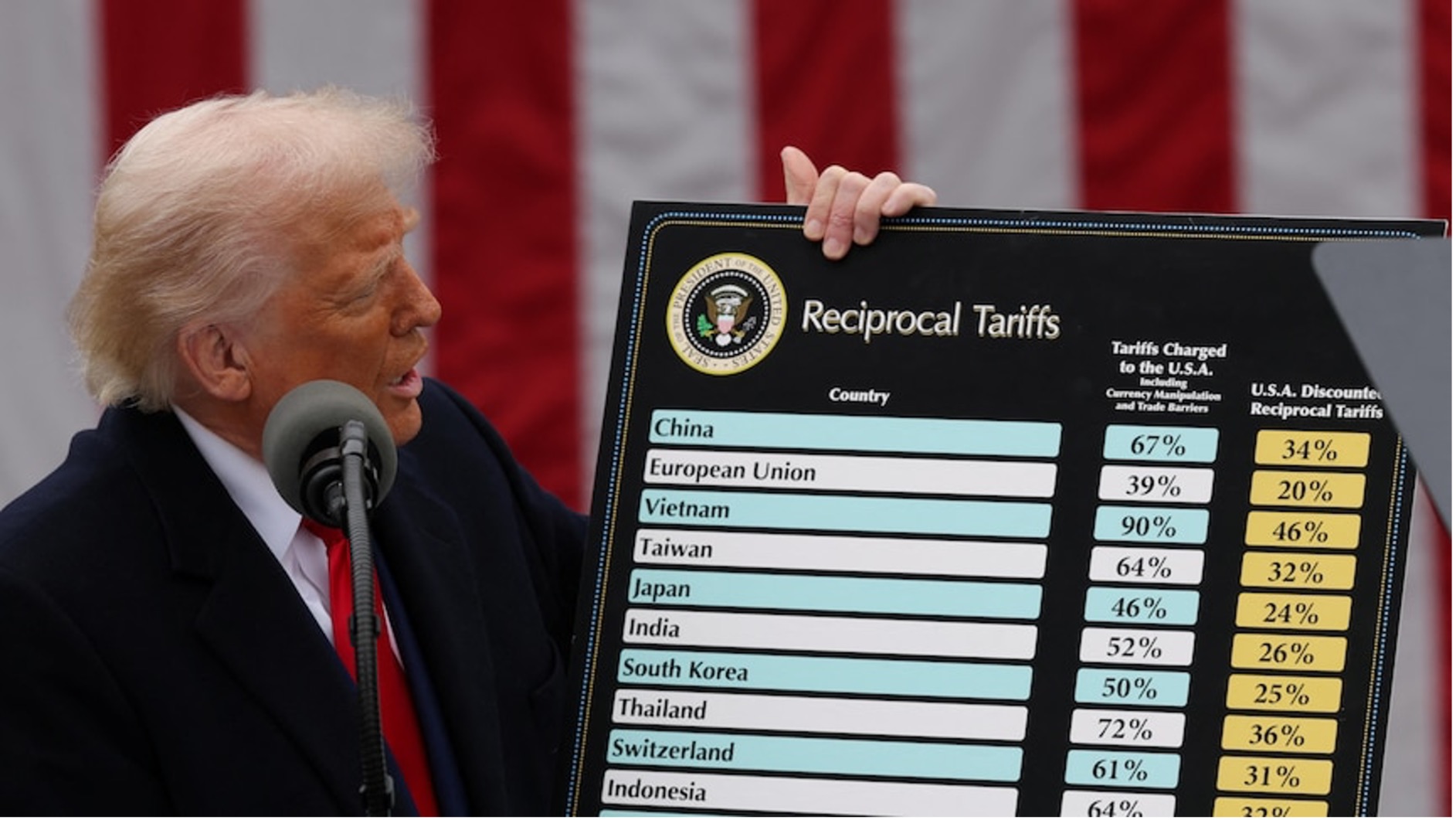

4月2日“解放日”终于到来,10%至50%的惩罚性税率不仅重塑了国际贸易格局,更将市场推向前所未有的不确定性。制造业萎缩、资金避险、经济衰退风险攀升……投资者正面临一场严峻的考验。在这样的背景下,盲目追随过往的“成长股神话”或固守单一资产类别,无异于将财富暴露于风险之中。本文将从策略调整、资产配置、行业选择等维度,为投资者提供一套应对危机的实战指南。特朗普的关税政策看似旨在重振美国制造业,但现实数据却给出了相反的答案。3月ISM制造业指数跌破荣枯线(49),工厂订单与就业数据同步下滑,揭示出企业信心疲软与供应链紊乱的双重困境。与此同时,全球贸易政策不确定性指数创历史新高,市场避险情绪迅速升温:美债收益率暴跌、黄金突破3100美元/盎司、美元指数走弱,资金正以最快速度逃离风险资产。
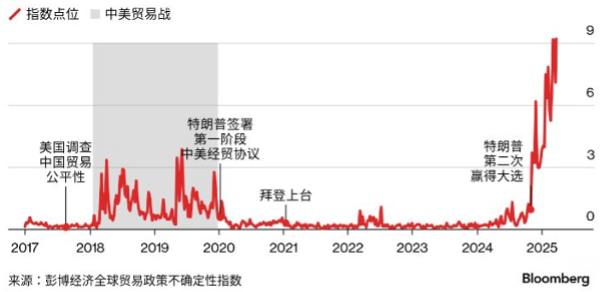
高盛已将美国经济衰退概率上调至35%,并三次下调标普500指数目标点位(6500→6200→5700),释放出强烈的预警信号。显然,这场关税战已不仅仅是贸易摩擦的升级,更是全球经济秩序重构的开端。在2024年的投资逻辑中,科技成长股(如“MEGA7”巨头)因其高增长性备受青睐。但当前环境下,这类资产对利率和政策敏感度极高,极易因市场情绪波动而剧烈震荡。投资者需重新平衡组合,从“进攻”转向“防御+灵活”——将防御性板块纳入核心配置。• 增配避险资产:黄金、美债与日元(1) 黄金作为终极避险工具,在美元信用波动期具备长期配置价值。当前金价突破历史高位,短期或有回调压力,但中长期仍可逢低布局。(2) 美债收益率虽处于低位,但其“避风港”属性在危机中无可替代。建议配置短期国债(如1-5年期),以规避长端利率的潜在波动风险。(3) 日元因其低息套利属性,常在全球动荡时被买入。投资者可通过外汇或货币基金间接持有。• 拥抱行业轮动:关注防御属性股票(1) 能源股:2025年以来,能源板块是标普11个行业板块中涨幅最大且7个没有下跌的行业板块之一。代表股票例如埃森克美孚在上周已经讲过,感兴趣的朋友可以翻阅上周五文章。(2) 医疗保健行业:2025年以来涨幅5%。代表股票有礼来公司、联合健康等(3) 公共事业板块:2025年以来涨幅约3%,高股息、低波动,适合作为“压舱石”。• 用衍生品为组合上“保险”对于无法大幅减仓的投资者,可以用金融衍生品管理风险。一是期货对冲,可以利用VIX期货,对冲标普500 系统性风险。二是反向做空,例如做空标普500,可在市场下跌时获取收益。需注意,衍生品交易杠杆高、风险大,适合有一定经验的投资者。

当然,关税正式执行之前,投资者需紧盯两大信号:一是贸易政策动向。4月9日更高税率落地后,要关注欧盟、亚洲国家的反制措施及WTO仲裁进展。二是经济数据拐点。若ISM指数重回扩张区间、非农就业回暖,或预示市场情绪修复。特朗普的“关税大棒”能否带来所谓的“黄金时代”?答案或许需要数年才能揭晓。但于投资者而言,当下的任务并非预测结果,而是为最坏情况做好准备,同时保留捕捉机遇的灵活性。正如华尔街那句老话:“牛市赚钱,熊市赚股。” 在风暴中保持冷静,方能在黎明到来时抢占先机。让子弹飞一会儿,但别忘了穿好防弹衣。联系方式:墨尔本 03 8658 0603悉尼 02 9188 0418中国地区(中文) 400 120 8537中国地区(英文) +248 4 671 903作者:Christine Li | GO Markets 墨尔本中文部
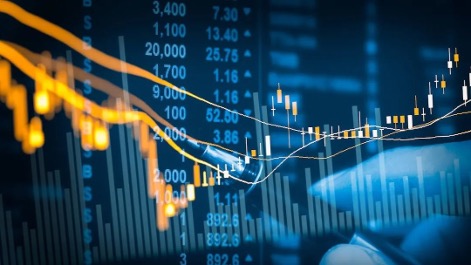

美国此次加关税,主要针对加拿大、墨西哥的几乎所有产品征收了25%和加拿大能源部分10%,以及对中国的10%税率。表面上与澳大利亚无直接关联,但由于全球经济联系紧密,这一政策实际上仍对澳洲经济和市场产生了间接影响。以下是几个可能的影响方向:1. 贸易转移效应:澳洲商品的间接受益由于美国对加拿大和墨西哥加征关税,当然也包括能源和汽车零部件方面,加拿大的原油和汽车出口受到严重打击。这可能导致美国转向其他供应国,而澳大利亚作为重要的矿产和能源输出国,有望填补部分市场缺口。矿产出口潜力:加拿大是美国镍、锂和铜等金属的重要供应国,而这些金属恰好也是澳大利亚的强项。如果美国减少从加拿大进口这些矿产,澳洲企业如必和必拓(BHP)和力拓(Rio Tinto)可能会增加对美出口,尤其是在电动车电池材料方面。此外,加拿大油砂原油受关税影响,或将促使美国增加对澳洲液化天然气(LNG)的采购,进一步巩固澳洲在全球能源市场的地位。

2. 全球产业链调整:澳洲制造业面临机遇与挑战此次关税升级,直接冲击了北美汽车产业链,在短期内可能造成供应链断裂。一些汽车零部件的生产基地可能从加拿大和墨西哥向澳洲或东南亚转移。汽车零部件出口:澳大利亚在汽车零部件制造方面虽无直接竞争力,但在高精密机械、铝制品和汽车电池材料上具有优势。如果北美车企重新布局全球供应链,澳洲有机会通过与美国本土企业合作,扩大零部件的出口份额。特斯拉、福特和通用等汽车巨头,短期内仍以北美供应链为主,未来在多元化供应链方面,澳洲锂矿可能成为重要补充。3. 农产品市场:潜在替代效应虽然本次关税政策主要针对汽车及能源产品,但加拿大与墨西哥作为美国重要农产品供应国,如因贸易战削弱其竞争力,澳大利亚的牛肉、小麦、葡萄酒等产品可能乘势而上。澳洲农产品的机会:加拿大小麦、玉米出口受限,美国市场存在替代性需求。墨西哥是美国主要牛肉进口国,如果供应链不畅,澳洲牛肉有望抢占部分市场。此外,特朗普政府对于中国加税可能使中国转而进口更多澳洲农产品,如大豆和乳制品,间接拉动澳洲农业出口。

4. 金融市场:商品货币的波动由于大宗商品价格波动,澳元作为商品货币,将不可避免受到波及。特朗普关税政策加剧市场不确定性,美元短期走弱,投资者可能会寻求更为稳健的避险资产如黄金之类。但由于市场普遍预期,能源和矿产价格将因全球供应链调整而上涨,铁矿石和铜的价格回暖可能支撑澳元汇率。当前,澳元兑美元稳定在0.62到0.63左右,虽然市场避险情绪短期内可能打压澳元,但由于大宗商品价格上涨,澳元在一定程度上具备抗跌性。

5. 资本市场反应:矿业股受益,消费板块承压澳洲资本市场对全球贸易摩擦十分敏感,尤其是对美国经济政策变化的反应。矿业股: 由于加税政策可能间接推动澳洲矿产品需求,矿业板块或有上行空间,如必和必拓和力拓。消费板块: 如果美国通胀压力增加,全球商品价格上涨,澳洲消费板块将因成本上升而面临利润压力。美元走弱背景下,资金部分流出美国市场,可能流向包括澳大利亚在内的非美市场。然而,由于澳股与美股整体趋势具有较高联动性,特别是在市场风险偏好变化时,澳股仍可能跟随美股波动。但在结构性调整下,能源和矿产类个股因大宗商品价格支撑,仍具备一定抗跌属性。总而言之,美国新一轮关税政策,虽然未直接针对澳大利亚,但其在汽车产业链、矿产能源市场和全球贸易格局中的连锁反应,仍可能给澳洲带来挑战和机遇并存的局面。短期内,澳大利亚需要加快供应链调整,抓住美国市场因关税引发的需求空缺。同时,澳洲企业应积极与美国本土企业建立合作关系,减少贸易战间接影响。资本市场方面,投资者可关注矿产和能源板块,在避险情绪和商品价格波动中寻找结构性机会。总之,面对特朗普的关税新政,澳大利亚必须在风险中寻找契机,灵活应对全球经济的不确定性。这不仅考验政策制定者的敏锐洞察,也要求企业及时调整战略,把握全球市场重构中的结构性红利。联系方式:墨尔本 03 8658 0603悉尼 02 9188 0418中国地区(中文) 400 120 8537中国地区(英文) +248 4 671 903作者:Yoyo Ma | GO Markets 墨尔本中文部


近期,美国总统特朗普的关税政策言论再次引发全球市场的剧烈反应。自他重提“美国优先”政策以来,全球市场已经经历了一系列剧烈波动,包括金属价格上涨、制造业成本上升、科技股遭受冲击,以及全球贸易紧张局势的升级。本文将全面分析这些政策带来的市场影响,并探讨哪些行业可能受益,哪些行业将面临巨大挑战。1. 金属市场:关税引发的价格波动1.1 黄金:避险情绪推高金价由于黄金具有避险属性,市场普遍认为,一旦特朗普开始对黄金进口征收关税,将引发市场恐慌情绪,导致黄金需求增加,价格飙升。最近,美国PCE通胀数据超预期,强化了市场对通胀的担忧,这也进一步刺激了黄金价格的上涨。✅ 市场影响:3月30日,纽约和伦敦黄金价格出现较大价差,反映出市场资金正在重新调整黄金头寸。4月1日,COMEX黄金价格突破2250美元/盎司,创历史新高。投资策略: 关注黄金ETF(如GLD)和黄金生产商(如巴里克黄金Barrick Gold, Newmont Corporation)1.2 铜:需求与供应错配,价格创历史新高特朗普近期暗示可能对铜进口征收额外关税,而美国是全球最大的铜消费国之一,任何关税举措都可能导致铜供应紧张,推高价格。✅ 市场影响:3月26日,COMEX铜价飙升至4.5美元/磅,创2021年以来新高。LME(伦敦金属交易所)库存持续下降,进一步加剧市场供应短缺预期。投资策略: 关注铜矿公司(如自由港麦克莫兰FCX、智利国家铜业Codelco),以及与电动汽车、电网建设相关的公司。1.3 钢铝:企业成本上升,制造业承压特朗普在3月12日宣布对进口钢铁和铝加征25%关税,导致美国国内钢铝价格上涨。虽然这对美国本土钢铁厂是利好消息,但却加重了汽车、建筑和航空等下游行业的成本压力。✅ 市场影响:美国中西部热轧钢价格上涨,达到1150美元/吨,较年初上涨30%。波音(Boeing)和福特(Ford)等公司警告,高昂的材料成本可能影响利润率。投资策略: 对钢铁制造商(如纽柯Nucor、美国钢铁US Steel)有利,但对依赖钢铝的行业(汽车、航空)形成压力。

2. 美元、加密货币与全球经济2.1 美元指数:特朗普关税导致汇率波动3月10日,特朗普关于“经济衰退可能性”的言论,导致美元指数下跌至 去年10月以来的最低点。美元疲软增加了市场对贵金属和加密货币的需求。2.2 比特币市场:投资者寻找避险资产3月10日,比特币价格短暂跌破 77000美元/枚,全球 21.52万人爆仓。机构投资者仍在增加对比特币的持仓,认为其是对冲政策风险的工具。3. 未来展望与投资者应对策略3.1 谁能化险为夷?✅ 受益行业:黄金、铜、钢铁等大宗商品本土制造业企业(钢铁、铝业)农业板块(因贸易补贴政策)3.2 谁可能溃不成军?❌ 受损行业:科技股(苹果、特斯拉等依赖全球供应链的公司)东南亚、新兴市场国家(因外资撤离)依赖进口原材料的企业(汽车、航空、建筑)4. 结论:如何应对市场不确定性?特朗普关税政策给全球市场带来了巨大的不确定性。从金属价格上涨,到制造业承压,再到科技股震荡,投资者需要密切关注政策变化,并采取灵活的投资策略。建议:黄金 & 铜:可作为避险资产持有制造业股(钢铁、铝)短期有望受益科技股 & 新兴市场:需谨慎持仓,关注政策走向联系方式:墨尔本 03 8658 0603悉尼 02 9188 0418中国地区(中文) 400 120 8537中国地区(英文) +248 4 671 903作者:Sylvia | GO Markets 悉尼中文部
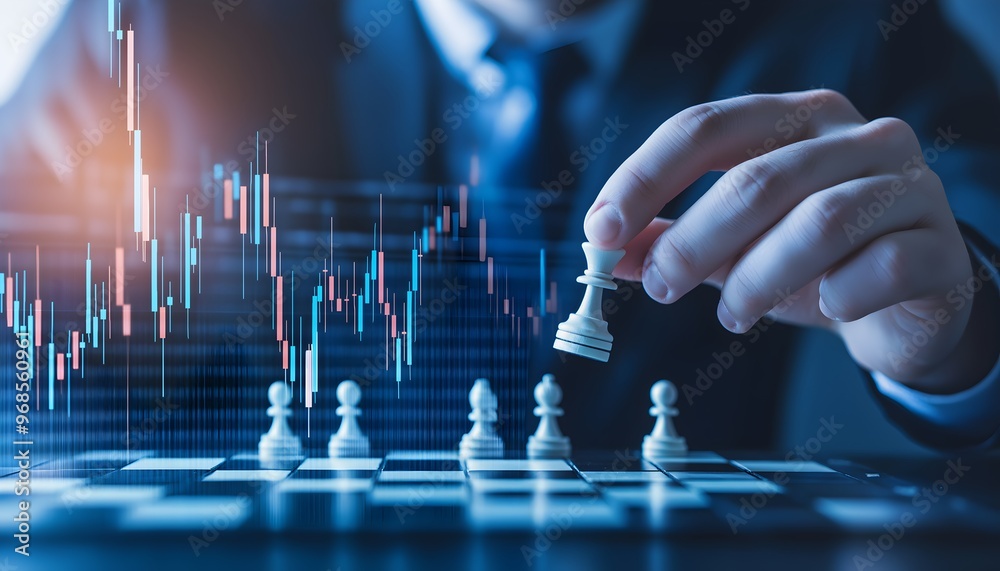

IntroductionIn the world of trading, "poor discipline" is frequently cited as the downfall of many aspiring and even experienced traders. It's the convenient explanation when trades go wrong: "I just need more discipline." However, this perspective misses a crucial insight—poor trading discipline is rarely the root problem. Rather, it's a symptom of deeper underlying issues that, if left unaddressed, will continue to manifest in trading behaviours that undermine success.This article explores why poor discipline should be viewed as a warning sign rather than the primary diagnosis and why identifying the true root causes is essential for lasting behavioural improvement in trading performance.The Real Cost of Poor Trading DisciplineBefore diving into the underlying causes, let's examine why addressing poor discipline is so critical by looking at its tangible and intangible costs:Financial Costs
- Direct monetary losses: Impulsive entries, failure to cut losses, and premature profit-taking all directly impact returns. For example, a trader who consistently moves their stop loss to avoid small losses often ends up with catastrophic drawdowns when positions move strongly against them.
- Compounding opportunity loss: Small discipline breaches compound dramatically over time. Consider a portfolio that takes a 20% loss from failure to exit a bad position—this now requires a 25% gain just to break even, pushing the recovery timeline significantly further. Over decades of trading, these setbacks can reduce final portfolio values by millions of dollars.
- Transaction costs accumulation: Overtrading from lack of discipline increases commissions and fees, creating a significant drag on performance. A trader who churns their account with 30 trades monthly instead of 10 well-planned entries might see 2-3% annual returns evaporate in transaction costs alone.
Psychological Costs
- Eroded confidence: Repeated discipline failures create self-doubt that bleeds into all trading decisions. When a trader has broken their rules multiple times, they begin to question their judgment even on valid setups. One trader described it as: "After three consecutive discipline breaches, I started second-guessing even my most high-probability trades, missing several winners that matched my criteria perfectly."
- Decision fatigue: The mental energy expended fighting poor impulses depletes cognitive resources needed for analysis. Studies show that willpower and decision-making ability diminish throughout the day when constantly tested. A trader fighting urges to deviate from their plan has less mental bandwidth for analysing market conditions or spotting opportunities.
- Emotional damage: The stress and anxiety from undisciplined trading can lead to burnout and abandonment of trading altogether. Many professional traders report that their worst losing streaks weren't caused by market conditions but by their emotional responses to initial losses, creating a downward spiral of poor decisions.
Strategic Costs
- Invalidated testing: Even the best trading strategies become untestable when executed inconsistently. When a trader backtests a strategy showing 60% win rate and 1:2 risk/reward ratio but then implements it inconsistently—perhaps holding losers too long or cutting winners short—the actual performance bears no resemblance to the expected results, making further optimization impossible.
- Misattributed failures: When discipline issues cloud results, traders often blame their strategy rather than their execution. A common scenario: a trader abandons a perfectly viable strategy because "it doesn't work," when in reality, they never truly followed the strategy's rules in the first place.
- Stunted development: Traders stuck in discipline loops rarely advance to higher-level trading concepts and strategies. Instead of progressing to sophisticated risk management, portfolio theory, or advanced market analysis, they remain trapped in the cycle of "discover strategy → implement poorly → abandon strategy → repeat."
Root Causes of Poor Trading DisciplinePoor discipline manifests in many ways—impulsive trades, inability to follow rules, emotional decision-making—but these behaviours stem from deeper sources. Let's examine the most common underlying causes:
- Misalignment Between Strategy and Psychology
- Risk tolerance mismatch: Trading with position sizes that trigger outsized emotional responses. For example, a trader comfortable with 0.5% risk per trade suddenly increases to 5% risk and finds themselves unable to follow their rules under the heightened pressure. One professional trader noted: "When I exceeded my natural risk threshold, even temporary drawdowns caused me to abandon my tested methods and make emotional decisions."
- Personality-strategy disconnect: Using trading approaches that conflict with natural psychological tendencies. A detail-oriented, methodical person might struggle with discretionary price action trading but excel with systematic, rules-based approaches. Conversely, intuitive, big-picture thinkers often feel constrained by highly mechanical systems and may unconsciously seek to override them.
- Time frame incompatibility: Trading time frames that don't match one's lifestyle, attention span, or stress tolerance. A parent with young children attempting to day trade during family hours will likely experience constant interruptions and stress, leading to impulsive decisions. Alternatively, someone with a high need for action and feedback might struggle with position trading where trades take weeks to unfold, leading to overtrading or premature exits.
- Knowledge and Preparation Gaps
- Inadequate planning: Trading without clearly defined entries, exits, and risk parameters. Consider a trader who enters a position based on a promising chart pattern but has no predetermined exit strategy—when the trade moves against them, they're forced to make decisions under pressure, often resulting in poor outcomes. A complete trading plan would specify: "Enter long at $X if Y condition is met, with stop loss at $Z (1% risk) and first target at 2R with trailing stop."
- Statistical misunderstanding: Failure to grasp the probabilistic nature of trading and proper expectancy. Many traders cannot emotionally handle normal losing streaks because they don't understand that even a strategy with a 65% win rate can easily produce 5-6 consecutive losses. Without this understanding, they abandon strategies prematurely or make modifications at exactly the wrong time.
- Incomplete strategy validation: Using approaches that haven't been thoroughly tested, creating doubt during execution. A trader who implements a strategy based on a few examples or back-of-napkin calculations lacks the confidence that comes from rigorous testing across different market conditions. This uncertainty breeds hesitation and second-guessing when real money is on the line.
- Cognitive and Emotional Factors
- Cognitive biases: Succumbing to confirmation bias, recency bias, and other thinking errors. For instance, a trader who has had two successful trades in the tech sector might overweight recent positive experiences and ignore risk factors when evaluating the next tech opportunity. Another common example is the gambler's fallacy—believing that after a string of losses, a win is "due," leading to oversized bets at precisely the wrong time.
- Identity attachment: Tying self-worth too closely to trading outcomes. When being right becomes a matter of personal validation rather than a probabilistic outcome, traders defend losing positions rather than accepting small losses. One reformed trader shared: "I realized I was viewing each trade as a referendum on my intelligence. Once I separated my self-image from my P&L, I could finally follow my stop-loss rules consistently."
- Unresolved psychological issues: Using trading as an outlet for excitement, validation, or escape. Some individuals trade to experience the thrill of risk rather than to execute a business plan, making discipline inherently difficult. Others use trading to escape boredom or dissatisfaction in other life areas, creating an emotionally charged environment where clear thinking is compromised.
- Environmental and Contextual Elements
- Financial pressure: Trading with needed living expenses or under external performance expectations. A trader who depends on monthly trading profits to pay bills faces enormous psychological pressure, making it difficult to maintain discipline during inevitable drawdowns. Similarly, someone trading family money or with partners looking over their shoulder may feel pressure to perform which leads to overtrading or excessive risk-taking.
- Inappropriate trading environment: Working in distracting or emotionally charged settings. The trader attempting to make decisions while monitoring multiple news sources, social media, and chat rooms is bombarded with information that triggers fear of missing out or fear of loss. Physical environment matters too—one hedge fund manager requires his traders to maintain clean, organized desks, finding that physical disorder correlates with mental disorder in trading decisions.
- Lack of accountability: Absence of mentorship, trading journals, or other feedback mechanisms. Trading in isolation without systematic review processes allows small discipline breaches to go unnoticed and uncorrected until they become habitual. A professional prop trader described their turnaround: "Everything changed when I started recording every trade with my reasoning before and after. Patterns of undisciplined behaviour became obvious, and I couldn't hide from them anymore."
The Path to Improved Trading DisciplineTrue improvement in trading discipline requires addressing root causes rather than symptoms:Self-Assessment and Awareness
- Conduct a thorough inventory of trading behaviours, noting patterns of discipline breaches. Review at least 100 recent trades, looking specifically for instances where you deviated from your stated rules. Categories might include moving stop losses, increasing position sizes after losses, trading outside planned hours, or ignoring pre-trade checklists.
- Identify emotional triggers that precede discipline lapses. Common triggers include consecutive losses, approaching monthly profit targets, trading during personal stress, or trading after reading market opinions that conflict with your analysis. One trader discovered that 70% of his discipline breaches occurred after checking his month-to-date performance, leading him to remove this information from his trading screen.
- Honestly evaluate whether your trading approach aligns with your personality and circumstances. Ask whether your chosen time frame matches your availability and temperament, whether your risk per trade truly feels comfortable, and whether your strategy's complexity level matches your analytical tendencies.
Targeted Interventions
- For strategy misalignment: Adjust position sizing, time frames, or trading style to better match your psychological makeup. A trader struggling with day trading's intensity might find swing trading more sustainable. Someone uncomfortable with discretionary decisions might adopt a fully systematic approach with clearly defined rules. Position sizing adjustments—often reducing size until emotional responses diminish—can be transformative.
- For knowledge gaps: Create comprehensive trading plans and enhance statistical understanding. Develop detailed playbooks for every scenario: entry conditions, initial stops, how to trail stops, when to add to positions, and multiple exit scenarios. Study probability and statistics to build confidence in your strategy's long-term expectancy despite short-term variance. One trader reported: "Understanding that 7 consecutive losses with my 65% win rate strategy had a 0.4% probability—rare but entirely normal—freed me from panic during losing streaks."
- For cognitive/emotional factors: Develop mindfulness practices and consider working with a trading coach. Regular meditation or breathing exercises before trading sessions can reduce emotional reactivity. Trading coaches who specialise in psychological aspects can identify blind spots and provide objective feedback. Some traders benefit from visualization exercises, mentally rehearsing and maintaining discipline through challenging scenarios before they occur.
- For environmental issues: Create a dedicated trading space and establish clear boundaries around trading capital. Physically separate trading from other activities with a dedicated workspace free from distractions. Financially separate trading capital from living expenses with at least 12 months of expenses in separate accounts. Develop protocols for communication with spouses or partners about trading results to reduce external pressure.
Systems and Guardrails
- Implement technological solutions to enforce discipline. Use broker platforms that allow automated stop losses that cannot be modified once set. Create custom alerts that flag when you're exceeding daily trade count limits or risk thresholds. One options trader programmed his platform to prevent opening new positions after 2pm when his historical data showed decreased decision quality.
- Create decision trees that remove in-the-moment choices during emotional market periods. Develop if-then contingency plans for various market scenarios: "If price breaks support level X, then I will execute plan Y without hesitation." Pre-commitment to specific actions reduces the cognitive burden during high-stress periods.
- Establish pre-commitment mechanisms that make discipline breaches more difficult. This might include trading with a partner who must approve stop-loss modifications, scheduling accountability calls with mentors after trading sessions or creating financial penalties for rule violations that are donated to charity. One creative trader set up an arrangement where breaking specific rules required him to make a substantial donation to a political cause he opposed—a powerful deterrent!
ConclusionPoor trading discipline is rarely just about willpower or character. By recognizing discipline problems as symptoms pointing to deeper causes, traders can address the true sources of their trading difficulties. This approach not only improves immediate trading performance but creates sustainable behavioural change that can transform trading results over the long term.Rather than berating yourself for discipline failures, use them as valuable data points that highlight areas needing attention in your trading psychology, knowledge, strategy, or environment. When these foundational elements are aligned, discipline becomes less of a struggle and more of a natural expression of a well-designed trading approach.The most successful traders understand that consistent discipline isn't achieved through force of will but through creating circumstances where disciplined behaviour is the path of least resistance. By addressing root causes rather than symptoms, they develop trading approaches that work with—rather than against—their natural tendencies, leading to sustainable success in the markets.
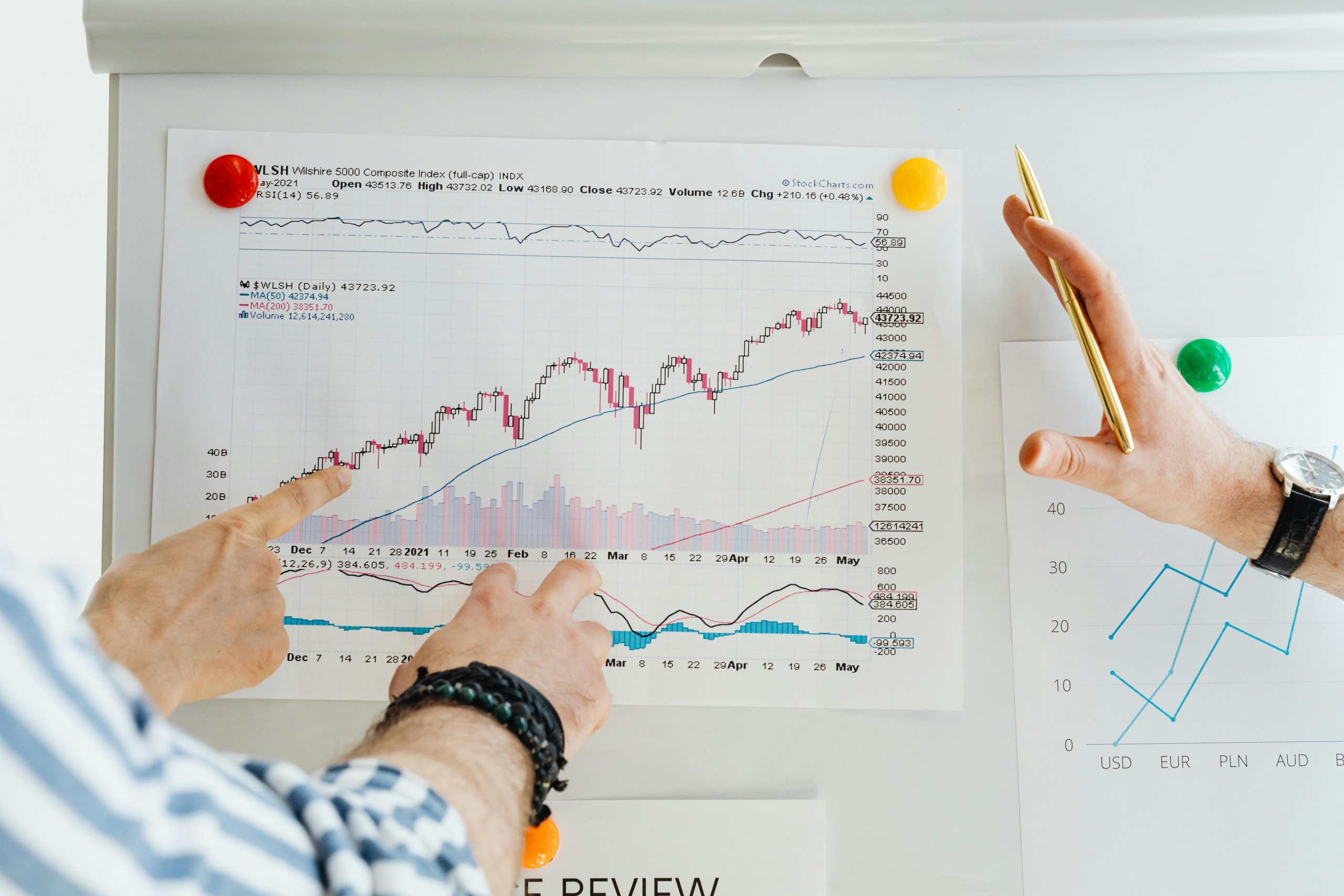

周五美股延续大跌行情,核心PCE超预期反弹至2.8%增幅,在市场担忧特朗普关税政策引发通胀风险时火上加油,纳指暴跌2.7%,标普大跌1.97%,道指也有1.67%的跌幅。各大板块纷纷下挫,本周末前半周或将延续跌势。4月2日临近,特朗普对等贸易落实细节备受市场关注,是坚定落地面对全世界的反制还是打嘴炮到最后又延期或者更改关税比例无从知晓,市场最讨厌的不确定性继续蔓延,而不确定性也是特朗普自带属性。本周非农数据来袭,预测值有较大回落,失业率也有增加,就业数据的预期结合核心PCE数据,进一步提升美联储上半年降息概率。AI板块集体下挫,刚上市的英伟达投资新贵CRWV破发开盘,收盘勉强保持发行价。七巨头集体大跌,谷歌,Meta和亚马逊均跌超4%。核电板块自然受影响继续大跌,成长股核技术跌幅巨大,电力供应分化为竞争性电供继续下跌,公共事业型电供成为优质防御性选择。量子计算,无人机等新兴题材继续大幅回调。目前的美股走得十分艰难,在美国经济似乎强势的大环境下有意被带入“温和衰退“。

美元兑现预期继续下行,目前机构已经中期看空美元,黄金成为避险资金争抢的筹码,金价再度上冲有望进一步创新高。恐慌大幅反弹,不确定行情下恐慌指数是个较强的对冲产品。油价小幅反弹,美油如期逼近70美元大关。周末比特币继续下行回到8万平台,短期较难上行。外汇方面美元下行下澳元却走得更为弱势,澳美再次回到0.63以下,今天澳股预计将暴跌。日元则表现较稳定,人民币被动跟随美元的风格依然未变。联系方式:墨尔本 03 8658 0603悉尼 02 9188 0418中国地区(中文) 400 120 8537中国地区(英文) +248 4 671 903作者:Xavier Zhang | GO Markets 高级分析师

